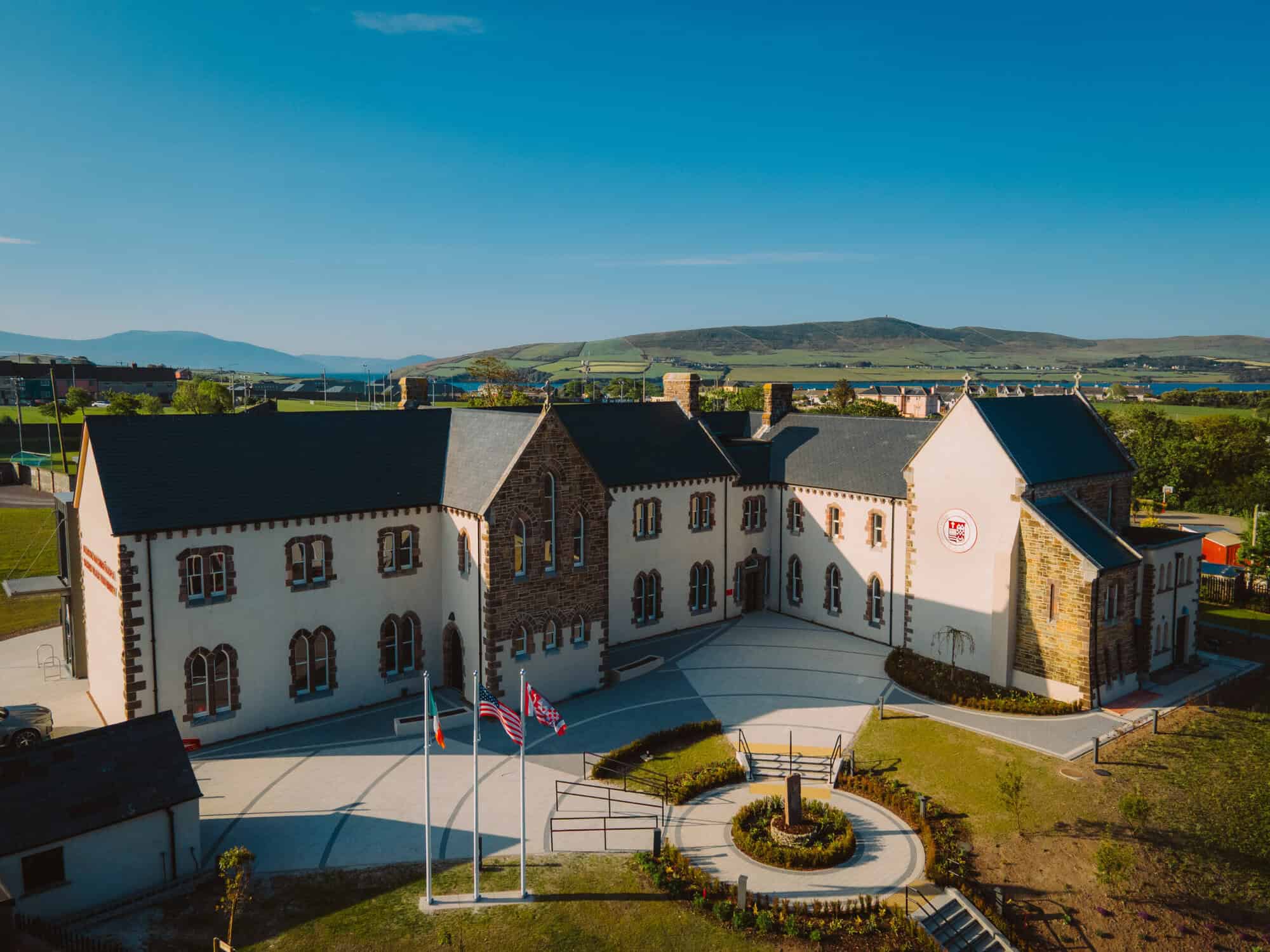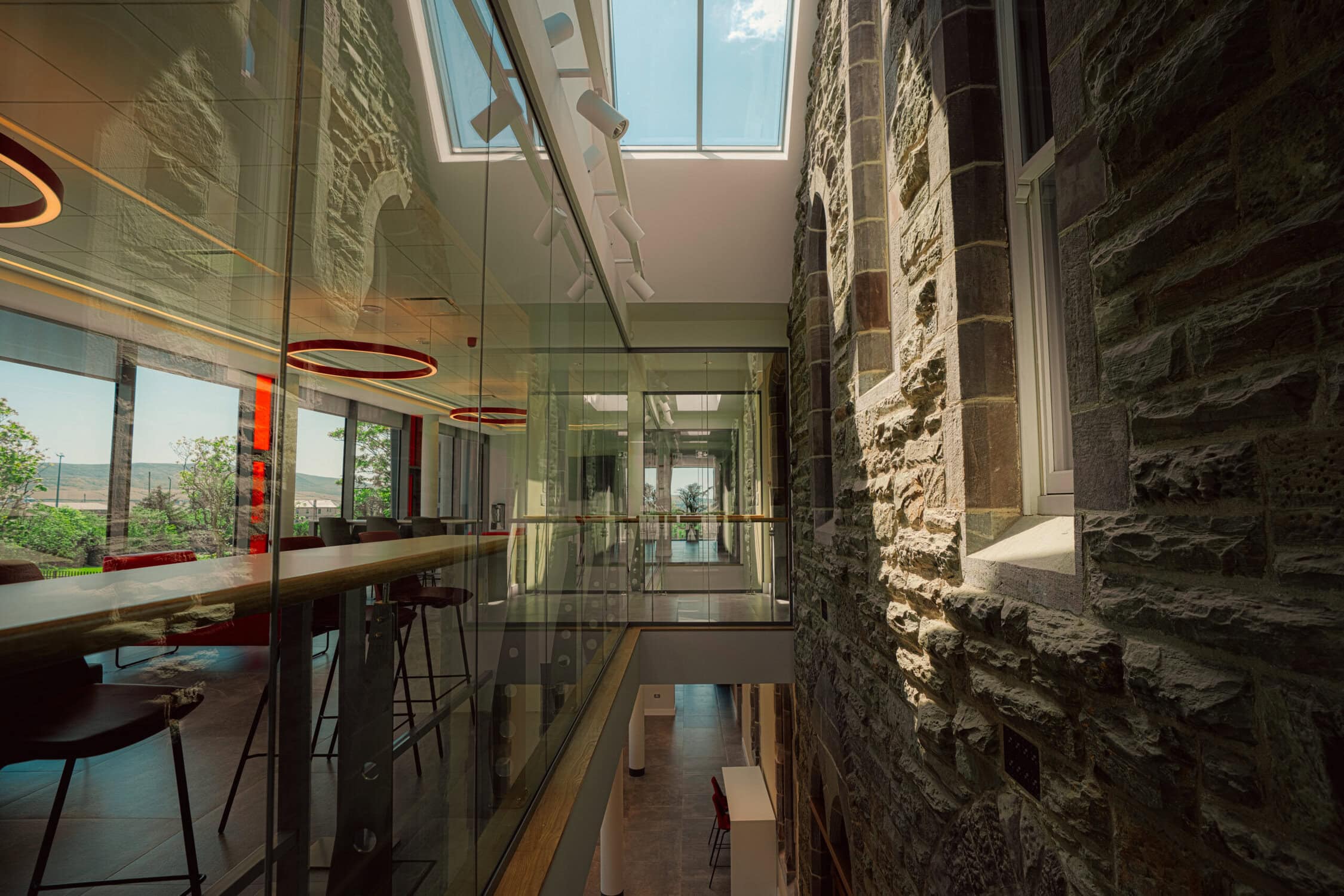After more than 20 years of history establishing its footing on the Emerald Isle, Sacred Heart’s Dingle campus opens new doors to the future.
BY TIMOTHY DEENIHAN
PHOTOGRAPHY BY DANIEL PASSAPERA

Time is not linear. This is not a treatise on quantum theory or the space-time continuum. This is Ireland. Cause and effect are not married to each other here. They’re not even dancing partners. They’re related, of course, but only distantly, like cousins who know of each other but have never actually met. Which is why it’s important to tell the story of SHU Dingle not from either perspective, but from both. Cause would have you believe the success of the program is the result of nearly three decades of steady, thoughtful development in everything from course offerings, curriculum, and location to building relationships and exercising a heartfelt commitment to community. And Cause would not be wrong. Because it is true that in the 1990s, SHU Religious Studies Professor Walter Brooks was running an exceptionally popular three-week summer Celtic religions program in Dublin with students housed at Trinity College. And the success of that one course did, in fact, ignite consideration of a larger program, even as costs were rising sharply at the time in Dublin, making that larger venture too risky for the still quite young University. Over the following years, however, Brooks, along with Jim Barquinero, vice president of student affairs and athletics, and Údaras na Gaeltachta, the Irish government’s office supporting the preservation, study and practice of the Irish language, explored numerous locations and locales as potential homes to an established and independent SHU facility.
There is a Goldilocks origin story springing from this time, claiming every place they looked was either too busy or expensive (like Dublin) or too remote and under-resourced (like Donegal) until, in 2002, Údaras na Gaeltachta suggested Dingle, a small Kerry coastal town that, though remote, had already established a respectable infrastructure in support of seasonal tourism. Further, retired professor Monsignor Pádraig Ó Fiannachta had recently established An Díseart Institute of Irish Spirituality and Culture in a convent run by the Sisters of Presentation––offering a natural partnership for an American Catholic university seeking to engage with, support and cultivate studies of the Irish language, Celtic spirituality and folklore, literature, music and history. Of course, in Cause’s version of the story, no success comes of its own accord. There would be three more years of continuing short course offerings in Dublin. Meanwhile, local relation – ships were forged in Dingle, and administrators developed operating procedures and framework to support the first cohort of only seven students arriving for a full semester in the spring of 2004. Deanna Fiorentino, the program’s first director of administration, recalls navigating the logistics of supporting that fledgling campus in a country where the University did not even hold a bank account at the time. Anthropology Professor Jerry Reid assumed the role of program director and began working to add elective offerings beyond Irish studies, including courses in the social and physical sciences. With every turn, SHU Dingle became more established and better resourced so that, in 2012, Professor Shery Watson was confident sending nursing students to Dingle for a two-week course in May. Soon after, with the continued expansion of science offerings and the hiring of Linda McCarthy and Fiona Barton, qualified Irish nurses with U.S.nursing experience, SHU nursing students be – gan to arrive for full semesters abroad––an opportunity largely inconceivable in most other degree nursing programs even now.

Growth (Cause will remind you) is not only a matter of who one is, but what one does. SHU Dingle hosted its first conference in 2017. Sea, Land and Spirit: Coastal Environment in the West of Ireland was an enormous success, bringing the combined disciplines of science and the humanities to examine the environment with more than 60 presentations and 125 participants from around the world. More, as the University begat the conference, the conference begat the John Moriarty Institute for Ecology and Spirituality, an Irish charitable organization with its educational wing supported by SHU, devised in the tradition of the Christian Irish hedge schools, taking its mission from the writing and work of its namesake philosopher. All of which, of course, barely lifts the lid on the greater machinations of a program grown from a handful of rented rooms at Trinity College over the off-season into a new campus opening this spring that not only houses more than 100 students for a full semester in any discipline the University has to offer, but also provides academic and student support to several other well-established universities seeking to follow in SHU’s footsteps. With a vision of the long game from the outset, the University, its representatives and partners have, over roughly 30 years, cultivated a program one could argue is the model of what higher-ed study abroad should be. And yet, however true, valid and impossible-to-overestimate the value of that vision and work has been, it is but part of the story. Because in Ireland, where time slows to an uncertain direction and old eyes seem to see more than three dimensions, the notion of what is––Effect’s noun to Cause’s verb––encompasses much more than what we can touch. Just ask Sarah Foley. “You’re always greeted with a smile,” Foley ’25 says at first, but seems frustrated at the inadequacy of cliché. There’s something more. Somehow there is a sense of belonging, even before being introduced. “A stranger says ‘Hi.’ You don’t know who they are,” she says. “But the next day they’re pouring you coffee.”
The suspicion that time in Ireland has a different sense of direction seeps into another story. While relating the usual endorsements of classes and field trips and opportunities, Foley tells of sitting on a bench outside a pub, rapt in the stories of her host on the bench, a spry 80-year-old charmer named Tom. Her friends call to her to join them, headed somewhere, but she passes, opting instead to stay on the bench. “It was perfect,” she says. “I just wanted to sit there and listen to this guy’s stories.” She has already admitted that SHU Dingle was a key reason for her application to the University in the first place. But as she talks of that moment on the bench with Tom, of being introduced to the living ghosts of lives gone by, there is the sense that the effect of her decision to apply had somehow been its cause all along. To the Irish, this makes perfect sense. To the Irish, it all makes perfect sense. That a remote coastal town, whose main street can be traversed in less time than it takes to pour a proper Guinness, is “lousy” with Ph.Ds (“lousy” meaning “inundated” in Irish vernacular) is a perfectly sensible thing. That homesickness here is not nearly as much of an issue as is “return-home sickness” requires no explanation. Finding yourself known by name as if you’re the prodigal child of a town you never lived in somehow makes the world both grand and common and, as Meghan Bernard ’25 found, “pushes you to be your authentic self.” But that’s Ireland for you. Students and parents alike are emboldened by the safety net of an established University program, but the real reassurance ends up being the island itself.

The blood knows its home in Ireland, it seems, whether you’re Irish or not. There’s a reason for that. But it’s a truth that resists being seen directly, rather like a star that becomes clearer by not looking directly at it. Toward the end of 2023, Professor Billy Mag Fhloinn found a 4,000-year-old neolithic tomb, the Altóir na Gréine, as part of his work with the Chorca Dhuibhne (“Deep Mapping”) Project launched by SHU Dingle to identify and preserve cultural heritage sites. The birth of Christ is only halfway between the building of that tomb and us, but the altar is still there. The stones toppled by time, but there. Not so far, really, from the pub where Tom and Foley sat talking. The Altóir is the sort of discovery that helps explain it all. The past tense doesn’t really exist in Ireland. Not in the way we think of it, anyway. Epochs are physically present—felt like zephyrs and best witnessed out of the corner of the eye. Time and space are blurred in their boundaries, so that words like then, there, here and now become largely interchangeable, defined only by context. And places like the Dingle Christian Brothers School (CBS), built in 1880 and continuously run by the Irish Christian Brothers until its closure in 2007, have a life of their own; inhaling and exhaling, but slowly, with the seasons; adapting, as life does, to the challenges set before it. Like Tom. Like the island itself.
Which is why, when SHU purchased the Dingle CBS in 2017, the intention was never to tear it down to build something new. Such an idea is unimaginable in Ireland. The school is a school at its heart. Always has been. If the ages and the accents of the students who pass through its doors have changed, well, change is part of life. Just as our understanding of the world has evolved through the years, then our means of understanding it must evolve, too. But imagining the future doesn’t have to mean forgetting the past any more than what you see can be separated from where you stand. A state-of-the-art educational facility born into the body of a school generations older than the greatest of great-grandparents. Old doesn’t become new again. It becomes a new it never was, but was always going to be. It’s infectious, the ageless wind of Ireland. It bestills the hustle. It humbles immediacy. It fills young lungs, and for the old, it reassures that everyone is a child next to Time. None of this, of course, is to deny the value of the effort it has taken to situate, cultivate and grow SHU Dingle. Only Sacred Heart has managed to develop a program of this nature, with cultural integration and academic rigor in a seamless weave. There is no accident in the many accomplishments and milestones of the last three decades since the program’s inception or the two since its birth. Sacred Heart University’s campus in Dingle thrives specifically on the drive, talent and vision of the many who have built and currently steer it. Just not solely so. There is something else. There is Ireland. And its mysteriously deep, swirling eddy of Time.

The full article can be found here
